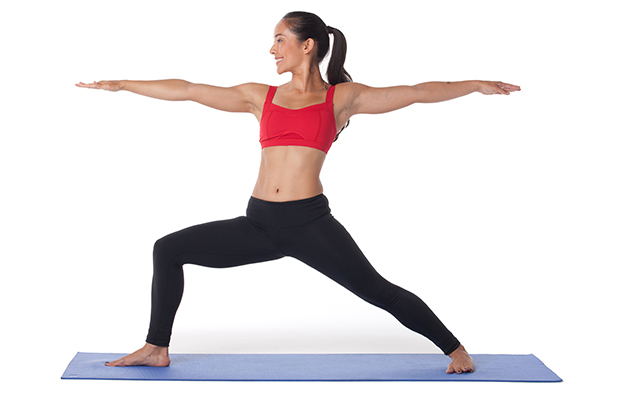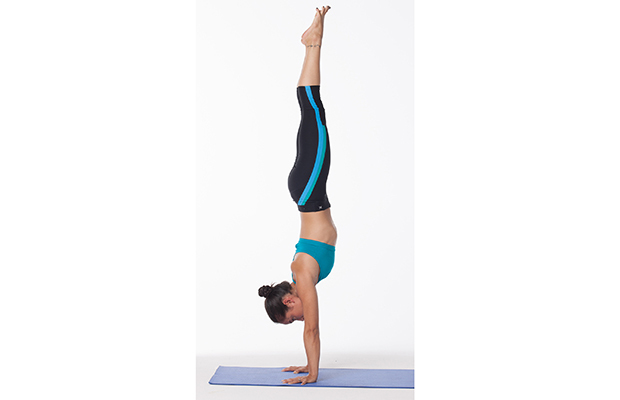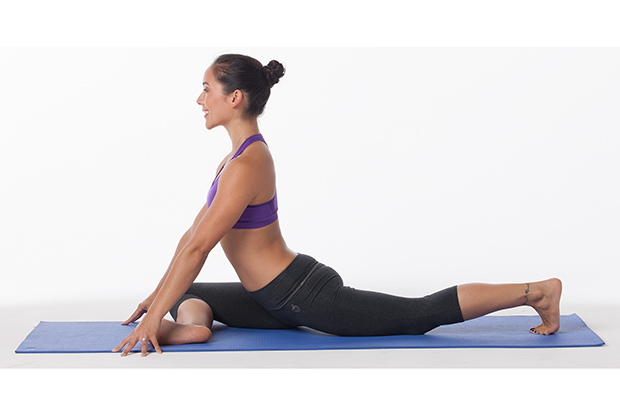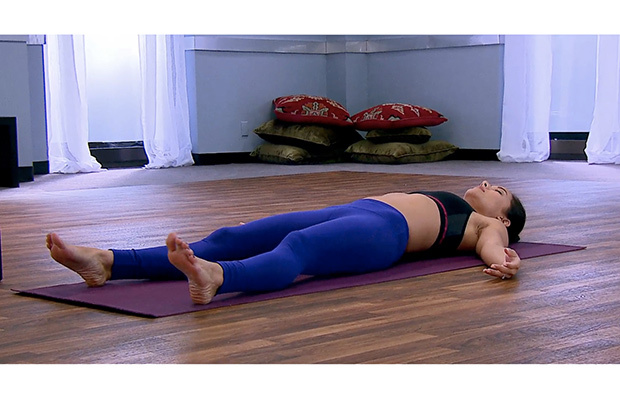'Tis the season to give thanks. We're used to expressing gratitude around a holiday meal, but many of us have probably never considered that fitness could help bring more gratitude into our lives. Research shows that acknowledging what you're thankful for can lead to a happier, healthier life. Like gratitude, yoga makes you healthier, too. And the physical and mental awareness that comes from a regular practice can help you feel gratitude toward yourself, others and your body. These five poses will keep the feeling strong long after you've woken up from a Thanksgiving dinner coma.
-
Cat/Cow Pose (Marjaryasana/Bitilasana)
 Like a cat's first big morning stretch, moving through a few cat/cows can really wake the body up and help you tune in. That's why it serves as such a good warm-up in yoga classes, says DailyBurn yoga expert Briohny Smyth. It's a great move for first thing in the morning or for when you've been sitting too long.
Like a cat's first big morning stretch, moving through a few cat/cows can really wake the body up and help you tune in. That's why it serves as such a good warm-up in yoga classes, says DailyBurn yoga expert Briohny Smyth. It's a great move for first thing in the morning or for when you've been sitting too long.
How to: Start on your hands and knees in a tabletop position, making sure your hands are aligned with your shoulders, your knees are in line with your hips and your head is in a neutral position. Then, slowly lift your gaze, chest and butt as you inhale (cow pose). On the exhale, round your back toward the ceiling while lowering your gaze (cat pose). "This is a great movement because it helps you get in touch with the body's capability of moving and getting rid of the kinks," says Smyth. And who wouldn't be thankful for that? -
Warrior II (Virabhadrasana II)
 While it's one of the basics, warrior II is considered among the most powerful of all the yoga asanas. The reason: It can help you feel gratitude toward the strength of your own body, says Smyth.
While it's one of the basics, warrior II is considered among the most powerful of all the yoga asanas. The reason: It can help you feel gratitude toward the strength of your own body, says Smyth.
How to: Begin standing with your legs out wide and both feet parallel to the front of your mat. Next, pivot your front foot so it's facing the front of the room and bend that knee deeply while keeping your back leg long and strong. Raise your arms up to shoulder level on either side of you, palms facing down, and move your gaze toward the front of the room as you bend your knee even deeper while keeping your torso upright. "While you're trying really hard to keep your arms up and bend your knees deep, you realize that just sitting in the pose makes you feel present," says Smyth. -
Handstand (Adho Mukha Vrksasana)
 Another powerful (and advanced) pose is the handstand. Not only does this impressive inversion require a strong back and shoulders, the core, glutes and legs work equally as hard. "When you're standing on just your hands you're grateful for the strength of your body to know what a handstand feels like," Smyth says.
Another powerful (and advanced) pose is the handstand. Not only does this impressive inversion require a strong back and shoulders, the core, glutes and legs work equally as hard. "When you're standing on just your hands you're grateful for the strength of your body to know what a handstand feels like," Smyth says.
How to: Start in downward facing dog with your fingertips a few inches away from a wall, hugging your upper arms toward one another and squeezing your shoulder blades together. Bend one knee and step the foot in closer to the wall, with the other leg remaining straight behind you (this will be your swing leg). Use the bent leg to hop up while your swing leg arcs toward the wall. At first, these hops may be enough, but eventually you’ll build the strength and finesse to kick both legs all the way to the wall. With even more practice, you won't need to rely on the wall and will instead be able to trust your own strength. -
Pigeon Pose (Eka Pada Rajakapotasana Variation)
 Stretches, especially hip stretches, allow you to connect with the tightness and tension in your body and mindfully, consciously let it go, Smyth says. "Any time you bring awareness to where you're tight and can release it, you feel grateful." Pigeon is a deep hip opener that has that effect.
Stretches, especially hip stretches, allow you to connect with the tightness and tension in your body and mindfully, consciously let it go, Smyth says. "Any time you bring awareness to where you're tight and can release it, you feel grateful." Pigeon is a deep hip opener that has that effect.
How to: To begin, start in downward facing dog, bend one knee and place it on your mat a little wider than your hip, with your shin parallel to the front of the mat. Fold forward over your shin with the other leg extended behind you, keeping the hips even as they press toward the floor. -
Corpse Pose (Savasana)
 Savasana, the final pose in a yoga class, is an opportunity to be still, calm and present while soaking in the benefits of your practice. "It's a great place to express gratitude and even connect with and feel gratitude for the people and things you have around you," says Smyth.
Savasana, the final pose in a yoga class, is an opportunity to be still, calm and present while soaking in the benefits of your practice. "It's a great place to express gratitude and even connect with and feel gratitude for the people and things you have around you," says Smyth.
How to: Settle into it by lying on your back with your legs slightly apart and your arms extended at your side, palms facing upward. Inhale and exhale through your nose, allowing your breath, muscles and mind to be completely relaxed.
No comments:
Post a Comment